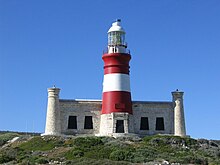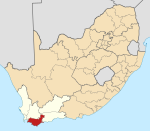Cape Agulhas

Cape Agulhas (/[invalid input: 'icon']əˈɡʌləs/; Portuguese: Cabo das Agulhas "Cape of Needles") is a rocky headland in the Western Cape, South Africa. It is the geographic southern tip of Africa and the official dividing point between the Atlantic and Indian Oceans. (The actual division between the ocean currents is, however, a different matter. The point where the Agulhas current meets the Benguela current fluctuates seasonally between Cape Agulhas and Cape Point.) Historically, the cape has been known to sailors as a major hazard on the traditional clipper route and is sometimes regarded as one of the great capes. It was most commonly known in English as Cape L'Agulhas until the 20th century. The town of L'Agulhas is located near to the cape.
Geography

Cape Agulhas is the southernmost point in the continent of Africa. It is located at 34°50′00″S 20°00′09.15″E / 34.83333°S 20.0025417°E in the Overberg region, 170 kilometres (105 mi) southeast of Cape Town. The cape was named by Portuguese navigators, who called it Cabo das Agulhas — Portuguese for "Cape of Needles" — after noticing that around the year 1500 the direction of magnetic north (and therefore the compass needle) coincided with true north in the region.[1] The cape is within the Cape Agulhas Local Municipality in the Overberg District of the Western Cape province of South Africa.[2] The official dividing line between the Indian and Atlantic oceans is defined by the International Hydrographic Organization to pass through Cape Agulhas.[3]
South of Cape Agulhas the warm Agulhas Current that flows south along the east coast of Africa retroflects back into the Indian Ocean. While retroflecting, it pinches off large ocean eddies (Agulhas rings) that drift into the South Atlantic Ocean and take enormous amounts of heat and salt into the neighbouring ocean. This mechanism constitutes one of the key elements in the global conveyor belt circulation of heat and salt.
Unlike its better-known relative, the Cape of Good Hope, Cape Agulhas is relatively unspectacular, consisting of a gradually curving coastline with a rocky beach. A survey marker indicates the location of the cape, which would otherwise be difficult to identify. The waters of the Agulhas Bank off the coast are quite shallow and are renowned as one of the best fishing grounds in South Africa.
The rocks that form Cape Agulhas belong to the Table Mountain Group, often loosely termed the Table Mountain sandstone. They are closely linked to the geological formations that are exposed in the spectacular cliffs of Table Mountain, Cape Point, and the Cape of Good Hope.
The climate is extremely mild, with no temperature or rainfall extremes. The average rainfall is 500 mm per annum,[contradictory] mostly received in winter (unverified, as closest data is from Bredasdorp). Temperature climate data is available for Cape Agulhas, averages are:
- Jan max: 23.8 °C (min: 17.7 °C); Jul max: 16.5 °C (min: 10.8 °C)
Climate
| Climate data for Cape Agulhas | |||||||||||||
|---|---|---|---|---|---|---|---|---|---|---|---|---|---|
| Month | Jan | Feb | Mar | Apr | May | Jun | Jul | Aug | Sep | Oct | Nov | Dec | Year |
| Record high °C (°F) | 28 (82) |
36 (97) |
35 (95) |
35 (95) |
33 (91) |
30 (86) |
29 (84) |
31 (88) |
32 (90) |
26 (79) |
30 (86) |
30 (86) |
36 (97) |
| Mean daily maximum °C (°F) | 23 (73) |
23 (73) |
22 (72) |
20 (68) |
18 (64) |
17 (63) |
16 (61) |
17 (63) |
17 (63) |
18 (64) |
20 (68) |
22 (72) |
20 (68) |
| Daily mean °C (°F) | 20 (68) |
20 (68) |
19 (66) |
17 (63) |
15 (59) |
14 (57) |
13 (55) |
13 (55) |
14 (57) |
15 (59) |
17 (63) |
19 (66) |
16 (61) |
| Mean daily minimum °C (°F) | 17 (63) |
17 (63) |
16 (61) |
14 (57) |
12 (54) |
11 (52) |
10 (50) |
10 (50) |
11 (52) |
12 (54) |
15 (59) |
16 (61) |
13 (55) |
| Record low °C (°F) | 8 (46) |
8 (46) |
9 (48) |
5 (41) |
4 (39) |
5 (41) |
3 (37) |
4 (39) |
4 (39) |
5 (41) |
5 (41) |
5 (41) |
3 (37) |
| Average rainfall mm (inches) | 20 (0.8) |
10 (0.4) |
30 (1.2) |
30 (1.2) |
50 (2.0) |
50 (2.0) |
50 (2.0) |
40 (1.6) |
40 (1.6) |
30 (1.2) |
20 (0.8) |
10 (0.4) |
440 (17.3) |
| Average rainy days | 1 | 1 | 3 | 3 | 4 | 4 | 4 | 3 | 3 | 2 | 2 | 1 | 36 |
| Average relative humidity (%) | 77 | 79 | 83 | 84 | 81 | 80 | 80 | 82 | 81 | 79 | 79 | 77 | 80 |
| Source: Weatherbase[4] | |||||||||||||
Shipping hazards

The sea off Cape Agulhas is notorious for winter storms and mammoth rogue waves, which can range up to 30 metres (100 ft) high[citation needed] and can sink even large ships. These conditions are caused by a number of factors. The naturally strong winds of the roaring forties, which blow from west to east, and the cold Antarctic Circumpolar Current flowing in the same direction, come up against the warmer Agulhas Current in the region of the cape. These conflicting currents of water of different densities, and the west winds blowing against the Agulhas Current, can create extremely hazardous wave conditions; these are further exacerbated by the shallow waters of the Agulhas Bank, a broad, shallow part of the continental shelf which juts 250 kilometres (155 mi) south from the cape, after which it falls steeply away to the abyssal plain.
These hazards have combined to make the cape notorious among sailors. The coast here is littered with wrecks: Arniston (1815), Cooranga (1964), Elise (1879), European (1877), Federal Lakes (1975), Geortyrder (1849), Gouritz (1981), and Gwendola (1968) are just a few of the vessels lost in the proximity of the "Cape of Needles."[5] Owing to the hazards and following the loss of several vessels, notably the Arniston, a lighthouse was built in 1848.[6] The lighthouse now holds a museum and a small rustic restaurant.
See also
- Cape Agulhas Local Municipality, the municipality containing Cape Agulhas.
- Agulhas National Park
- Cape of Good Hope, near Cape Town, which is often incorrectly regarded as the southernmost point of Africa.
- SS Wafra oil spill
References
- ^ Patricia Seed: Discovery of the Coincidence of Magnetic and True North
- ^ Cape Agulhas Municipality official home page
- ^ "Limits of Oceans and Seas, 3rd edition" (PDF). International Hydrographic Organization. 1953. Retrieved 7 February 2010.
- ^ "Climate Statistics for Cape Agulhas, South Africa". Retrieved 22 February 2012.
- ^ Marine Casualty Database Southern African Coast (copy at the Internet Archive), from NCS Cape Town
- ^ "History: Proposals for a Lighthouse at L'Agulhas". L'Agulhas web site. 29 July 2005. Archived from the original on 19 October 2007. Retrieved 15 November 2007.


